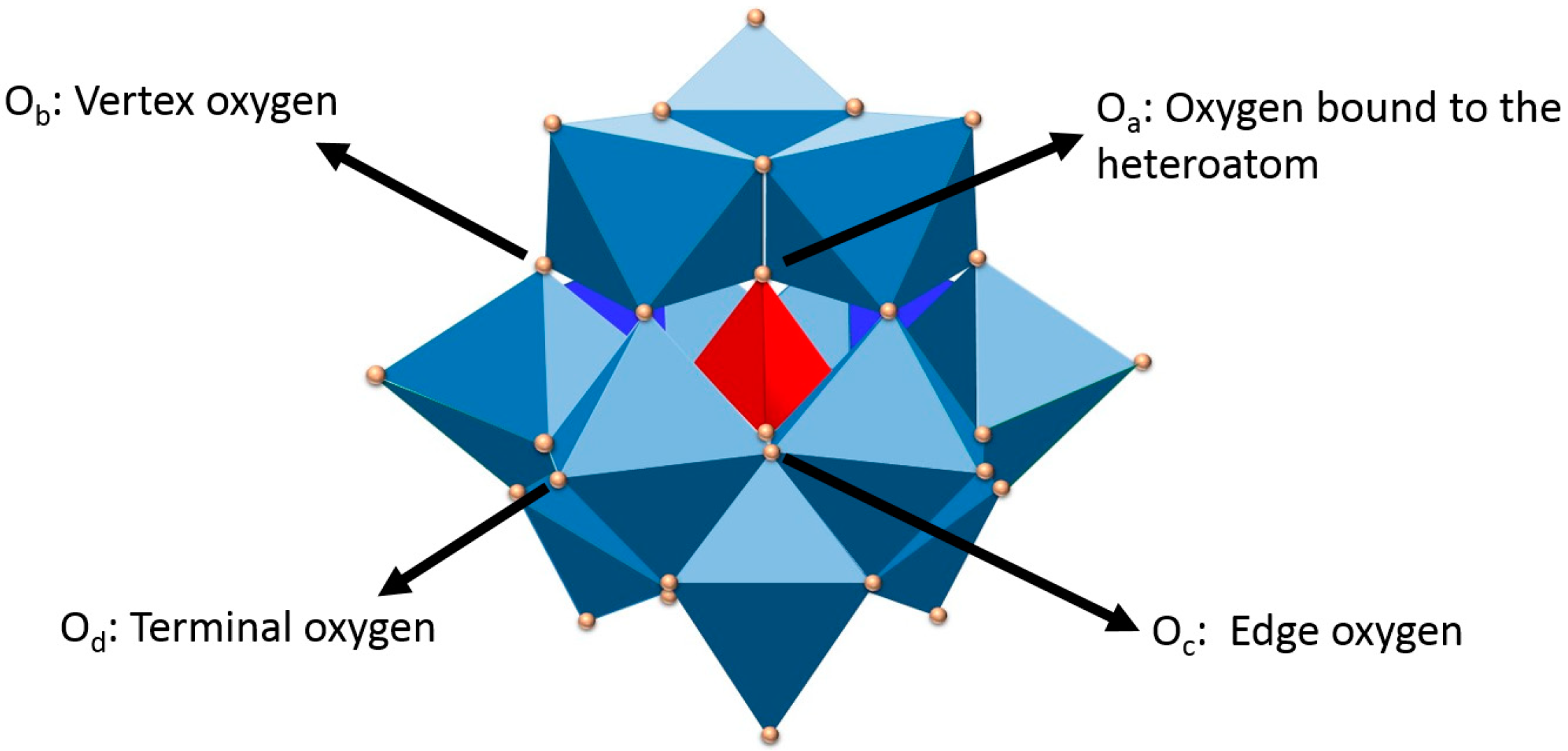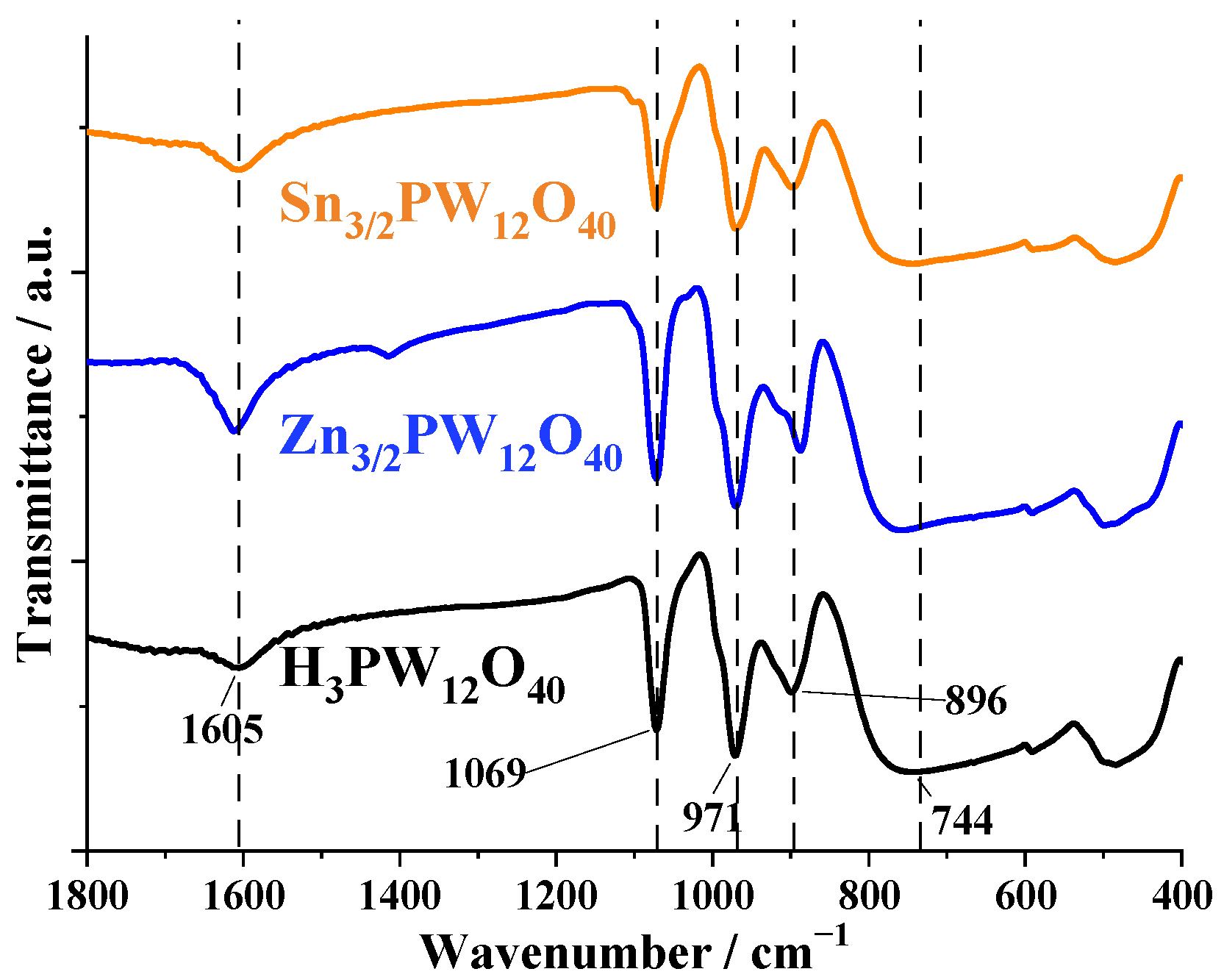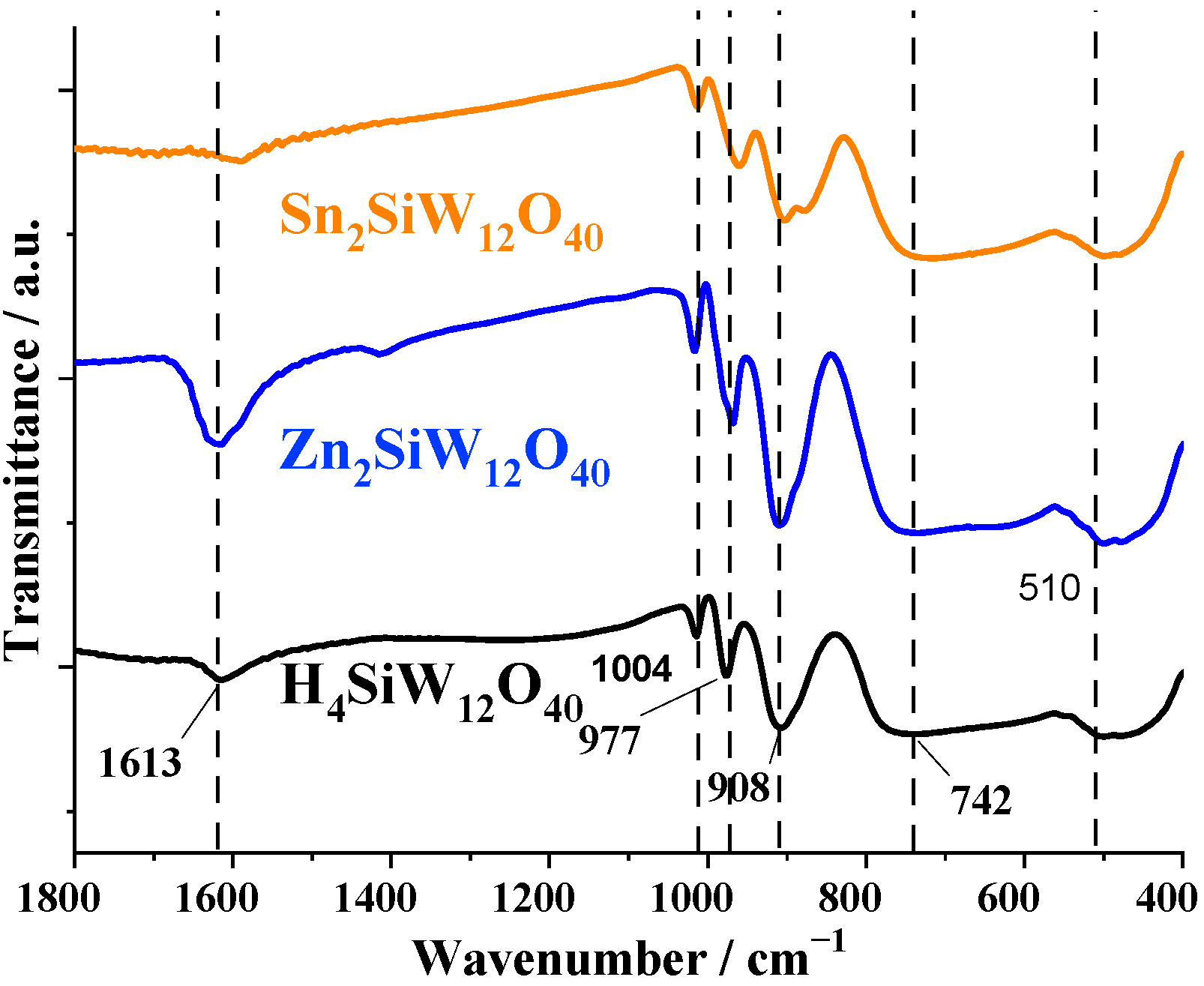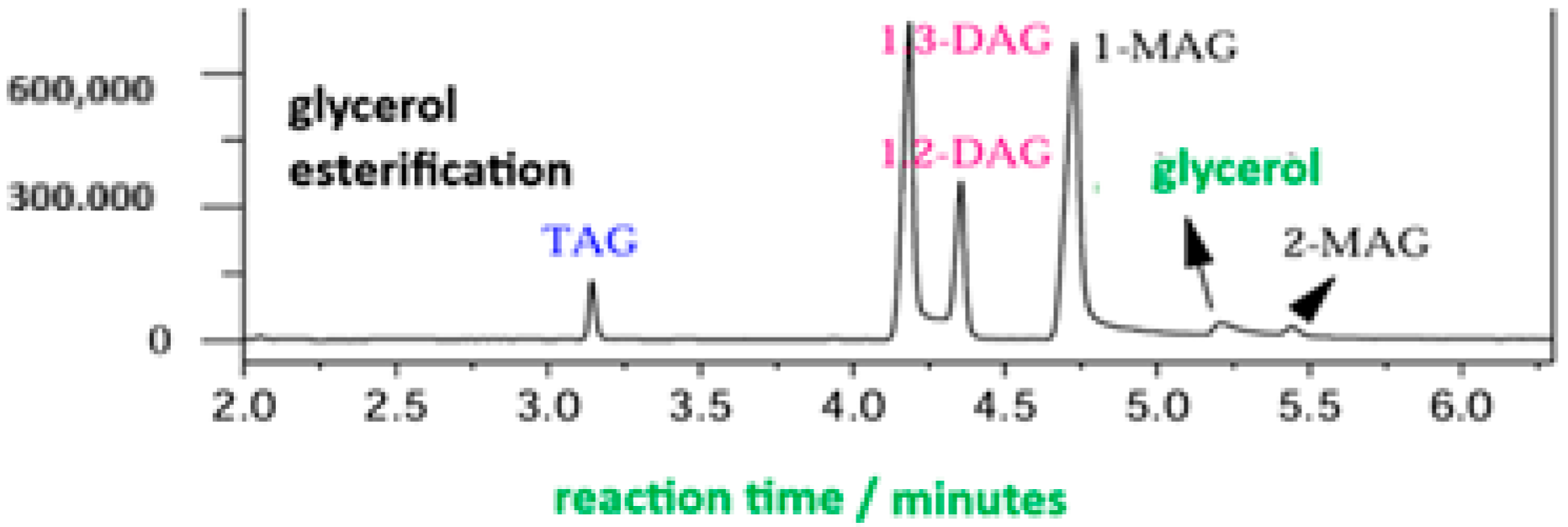Silicotungstate- or Phosphotungstate-Catalyzed Glycerol Esterification with Acetic Acid: A Comparison of Zinc and Tin Salts
Abstract
1. Introduction
2. Materials and Methods
2.1. Chemicals
2.2. Synthesis and Characterization of Tin- or Zinc-Exchanged Silicotungstic and Phosphotungstic Acid Salts
2.3. Catalyst Characterization
2.4. Catalytic Runs
3. Results and Discussion
3.1. Catalyst Characterization
3.2. Catalytic Runs: A Comparison of Silicotungstates and Phosphotungstates of Zinc or Tin
3.3. The Effect of Main Reaction Parameters
4. Conclusions
Author Contributions
Funding
Data Availability Statement
Acknowledgments
Conflicts of Interest
References
- Asghar, U.; Rafiq, S.; Anwar, A.; Iqbal, T.; Ahmed, A.; Jamil, F.; Khurram, M.S.; Akbar, M.M.; Farooq, A.; Shah, N.S.; et al. Review on the progress in emission control technologies for the abatement of CO2, SOx and NOx from fuel combustion. J. Environ. Chem. Eng. 2021, 9, 106064. [Google Scholar] [CrossRef]
- Zhao, H.T.; Wu, T.; He, J.; Kingman, S.; Shi, K.Q.; Shen, D.; Zhang, Y.Y. Simultaneous removal of SOx and NOx in flue gas at power stations over a Cu/Na-13X zeolite catalyst. Adv. Mater. Res. 2013, 650, 125–129. [Google Scholar] [CrossRef]
- Islam, A.; Teo, S.H.; Ng, C.H.; Taufiq-Yap, Y.H.; Choong, S.Y.T.; Awual, M.R. Progress in recent sustainable materials for greenhouse gas (NOx and SOx) emission mitigation. Prog. Mater. Sci. 2023, 132, 101033. [Google Scholar] [CrossRef]
- Anuar, M.R.; Abdullah, A.Z. Challenges in biodiesel industry with regards to feedstock, environmental, social and sustainability issues: A critical review. Renew. Sustain. Energy Rev. 2016, 58, 208–223. [Google Scholar] [CrossRef]
- da Silva, M.J.; Neide Paloma Gonçalves Lopes, N.P.G.; Rodrigues, A. A, Biodiesel Additives Synthesis Using Solid Heteropolyacid Catalysts. Energies 2023, 16, 1332. [Google Scholar] [CrossRef]
- Dodson, J.R.; Avellar, T.; Athayde, J.; Mota, C.J. Glycerol acetals with antioxidant properties. Pure Appl. Chem. 2014, 86, 905–911. [Google Scholar] [CrossRef]
- da Silva, M.J.; Ribeiro, C.A.J.; Rodrigues, A.A.; Silva, T.A. Fuel Bioadditives Synthesis from Furfural Glycerol Condensation over Vanadium-Substituted Cesium Phosphomolybdate Salts. Catal. Lett. 2024, 154, 3251–3263. [Google Scholar] [CrossRef]
- Luque, R.; Lovett, J.C.; Datta, B.; Clancy, J.; Campelo, J.M.; Romero, A.A. Biodiesel as feasible petrol fuel replacement: A multidisciplinary overview. Energy Environ. Sci. 2010, 3, 1706–1721. [Google Scholar] [CrossRef]
- Kirchhecker, S.; Dell’Acqua, A.; Angenvoort, A.; Spannenberg, A.; Ito, K.; Tin, S.; Taden, A.; de Vries, J.G. HMF–glycerol acetals as additives for the debonding of polyurethane adhesives. Green Chem. 2021, 23, 957–965. [Google Scholar] [CrossRef]
- Monteiro, M.R.; Kugelmeier, C.L.; Pinheiro, R.S.; Batalha, M.O.; da Silva César, A. Glycerol from biodiesel production: Technological paths for sustainability. Renew. Sustain. Energy Rev. 2018, 88, 109–122. [Google Scholar] [CrossRef]
- Tan, H.W.; Aziz, A.A.; Aroua, M.K. Glycerol production and its applications as a raw material: A review. Renew. Sustain. Energy Rev. 2013, 27, 118–127. [Google Scholar] [CrossRef]
- Cornejo, A.; Barrio, I.; Campoy, M.; Lázaro, J.; Navarrete, B. Oxygenated fuel additives from glycerol valorization. Main production pathways and effects on fuel properties and engine performance: A critical review. Renew. Sustain. Energy Rev. 2017, 79, 1400–1413. [Google Scholar] [CrossRef]
- Bohmer, N.; Roussiere, T.; Kuba, M.; Schunk, S.A. Valorisation of glycerol as renewable feedstock: Comparison of the exploration of chemical transformation methods aided by high throughput experimentation. Comb. Chem. High Throughput Screen. 2012, 15, 123–135. [Google Scholar] [CrossRef] [PubMed]
- Rodrigues, A.; Bordado, J.C.; Galhano dos Santos, R. Upgrading the glycerol from biodiesel production as a source of energy carriers and chemicals—A technological review for three chemical pathways. Energies 2017, 10, 1817. [Google Scholar] [CrossRef]
- Requena, S.O.; Montiel, C.; Máximo, F.; Gómez, M.; Murcia, M.D.; Bastida, J. Esters in the Food and Cosmetic Industries: An Overview of the Reactors Used in Their Biocatalytic Synthesis. Materials 2024, 17, 268–298. [Google Scholar] [CrossRef] [PubMed]
- Jia, M.; Jiang, L.; Niu, F.; Zhang, Y.; Sun, X. A novel and highly efficient esterification process using triphenylphosphine oxide with oxalyl chloride. R. Soc. Open Sci. 2023, 5, 171988. [Google Scholar] [CrossRef]
- Avhad, M.R.; Marchetti, J.M. Innovation in solid heterogeneous catalysis for the generation of economically viable and ecofriendly biodiesel: A review. Catal. Rev. 2016, 58, 157–208. [Google Scholar] [CrossRef]
- Lotero, E.; Liu, Y.; Lopez, D.E.; Suwannakarn, K.; Bruce, D.A.; Goodwin, J.G. Synthesis of biodiesel via acid catalysis. Ind. Eng. Chem. Res. 2005, 44, 5353–5363. [Google Scholar] [CrossRef]
- Corma, A.; Garcia, H. Lewis acids: From conventional homogeneous to green homogeneous and heterogeneous catalysis. Chem. Rev. 2003, 103, 4307–4366. [Google Scholar] [CrossRef]
- Guerrero-Ruíz, F.; Yara-Varon, E.; González, M.D.; Torres, M.; Salagre, P.; Canela-Garayoa, R.; Cesteros, Y. Use of biobased crude glycerol, obtained biocatalytically, to obtain biofuel additives by catalytic acetalization of furfural using SAPO catalysts. Fuel 2022, 319, 123803. [Google Scholar] [CrossRef]
- Samoilov, V.O.; Ramazanov, D.N.; Nekhaev, A.I.; Maximov, A.L.; Bagdasarov, L.N. Heterogeneous catalytic conversion of glycerol to oxygenated fuel additives. Fuel 2016, 172, 310–319. [Google Scholar] [CrossRef]
- Natalino, R.; Varejão, E.V.V.; Da Silva, M.J.; Cardoso, A.L.; Fernandes, S.A. p-Sulfonic acid calix [n] arenes: The most active and water tolerant organocatalysts in esterification reactions. Catal. Sci. Technol. 2014, 4, 1369–1375. [Google Scholar] [CrossRef]
- Trombettoni, V.; Lanari, D.; Prinsen, P.; Luque, R.; Marrocchi, A.; Vaccaro, L. Recent advances in sulfonated resin catalysts for efficient biodiesel and bio-derived additives production. Prog. Energy Comb. Sci. 2018, 65, 136–162. [Google Scholar] [CrossRef]
- Kim, I.; Kim, J.; Lee, D. A comparative study on catalytic properties of solid acid catalysts for glycerol acetylation at low temperatures. Appl. Catal. B Environ. 2014, 148, 295–303. [Google Scholar] [CrossRef]
- Batalha, D.C.; Ferreira, S.O.; da Silva, R.C.; da Silva, M.J. Cesium-Exchanged Lacunar Keggin Heteropolyacid Salts: Efficient Solid Catalysts for the Green Oxidation of Terpenic Alcohols with Hydrogen Peroxide. ChemistrySelect 2020, 5, 1976–1986. [Google Scholar] [CrossRef]
- Kozhevnikov, I. Sustainable heterogeneous acid catalysis by heteropoly acids. In Handbook of Green Chemistry; Wiley Online Library: Hoboken, NJ, USA, 2010; pp. 153–174. [Google Scholar] [CrossRef]
- Da Silva, M.J.; Liberto, N.A. Soluble and solid-supported Keggin heteropolyacids as catalysts in reactions for biodiesel production: Challenges and recent advances. Curr. Org. Chem. 2016, 20, 1263–1283. [Google Scholar] [CrossRef]
- Zhu, S.; Zhu, Y.; Gao, X.; Mo, T.; Zhu, Y.; Li, Y. Production of bioadditives from glycerol esterification over zirconia supported heteropolyacids. Bioresour. Technol. 2013, 130, 45–51. [Google Scholar] [CrossRef]
- Betiha, M.A.; Hassan, H.M.; El-Sharkawy, E.A.; Al-Sabagh, A.M.; Menoufy, M.F.; Abdelmoniem, H.M. A new approach to polymer-supported phosphotungstic acid: Application for glycerol acetylation using robust sustainable acidic heterogeneous–homogenous catalyst. Appl. Catal. B. 2016, 182, 15–25. [Google Scholar] [CrossRef]
- Da Silva, M.J.; Rodrigues, A.A. Metal silicotungstate salts as catalysts in furfural oxidation reactions with hydrogen peroxide. Mol. Catal. 2020, 493, 111104. [Google Scholar] [CrossRef]
- Timofeeva, M.N. Acid catalysis by heteropoly acids. Appl. Catal. A 2003, 256, 19–35. [Google Scholar] [CrossRef]
- Coronel, N.C.; da Silva, M.J.; Ferreira, S.O.; da Silva, R.C.; Natalino, R. K5PW11NiO39-catalyzed oxidation of benzyl alcohol with hydrogen peroxide. ChemistrySelect 2019, 4, 302–310. [Google Scholar] [CrossRef]
- Patel, A.; Singh, S. A green and sustainable approach for esterification of glycerol using 12 tungstophosphoric acid anchored to different supports: Kinetics and effect of support. Fuel 2014, 118, 358–364. [Google Scholar] [CrossRef]
- Coronel, N.C.; da Silva, M.J. Lacunar Keggin heteropolyacid salts: Soluble, solid and solid-supported catalysts. J. Clust. Sci. 2018, 29, 195–205. [Google Scholar] [CrossRef]
- Zhu, S.; Gao, X.; Dong, F.; Zhu, Y.; Zheng, H.; Li, Y. Design of a highly active silver exchanged phosphotungstic acid catalyst for glycerol esterification with acetic acid. J. Catal. 2013, 306, 155–163. [Google Scholar] [CrossRef]
- Castro, G.A.D.; Lopes, N.P.G.; Fernandes, S.A.; da Silva, M.J. Copper phosphotungstate-catalyzed microwave-assisted synthesis of 5-hydroxymethylfurfural in a biphasic system. Cellulose 2022, 29, 5529–5545. [Google Scholar] [CrossRef]
- Da Silva, M.J.; Liberto, N.A.; Leles, L.C.D.A.; Pereira, U.A. Fe4(SiW12O40)3-catalyzed glycerol acetylation: Synthesis of bioadditives by using highly active Lewis acid catalyst. J. Mol. Catal. A 2016, 422, 69–83. [Google Scholar] [CrossRef]
- Pizzio, L.R.; Blanco, M.N. A contribution to the physicochemical characterization of nonstoichiometric salts of tungstosilicic acid. Micropor. Mesopor. Mater. 2007, 103, 40–47. [Google Scholar] [CrossRef]
- Popa, A.; Sasca, V.; Bajuk-Bogdanović, D.; Holclajtner-Antunović, I. Synthesis, characterization and thermal stability of cobalt salts of Keggin-type heteropolyacids supported on mesoporous silica. J. Therm. Anal. Calorim. 2016, 126, 1567–1577. [Google Scholar] [CrossRef]
- Holclajtner-Antunović, I.; Mioč, U.B.; Todorović, M.; Jovanović, Z.; Davidović, M.; Bajuk-Bogdanović, D.; Laušević, Z. Characterization of potassium salts of 12-tungstophosphoric acid. Mater. Res. Bull. 2010, 45, 1679–1684. [Google Scholar] [CrossRef]
- Méndez, L.; Torviso, R.; Pizzio, L.; Blanco, M. 2-Methoxynaphthalene acylation using aluminum or copper salts of tungstophosphoric and tungstosilicic acids as catalysts. Catal. Today 2011, 173, 32–37. [Google Scholar] [CrossRef]
- Villabrille, P.; Romanelli, G.; Gassa, L.; Vazquez, P.; Caceres, C. Synthesis and characterization of Fe-and Cu-doped molybdovanadophosphoric acids and their application in catalytic oxidation. Appl. Catal. A 2007, 324, 69–76. [Google Scholar] [CrossRef]
- Borghese, S.; Louis, B.; Blanc, A.; Pale, P. Design of silver (I)-heteropolyacids: Toward the molecular control of reactivity in organic chemistry. Catal. Sci. Technol. 2011, 1, 981–998. [Google Scholar] [CrossRef]
- Berry, F.J.; Derrick, G.R.; Mortimer, M. Identification and characterization of stable phases of silicotungstic acid, H4SiW12O240∙nH2O. Polyhedron 2014, 68, 17–22. [Google Scholar] [CrossRef]
- Chaves, D.M.; Ferreira, S.O.; da Silva, R.C.; Natalino, R.; da Silva, M.J. Glycerol Esterification over Sn(II)-Exchanged Keggin Heteropoly Salt Catalysts: Effect of Thermal Treatment Temperature. Energy Fuels 2019, 33, 7705–7716. [Google Scholar] [CrossRef]











| Exp. | Catalyst | Weight (%) | |||
|---|---|---|---|---|---|
| Sn | X 1 | W | O | ||
| 1 | H4SiW12O40 | 0 | 1 | 77 | 22 |
| 2 | Sn2SiW12O40-773 | 6 | 1 | 70 | 23 |
| 3 | H3PW12O40 | 0 | 1 | 77 | 22 |
| 4 | Sn3/2PW12O40-773 | 3 | 1 | 73 | 23 |
| Entry | Catalyst/Thermal Treatment Temperature | Conversion/% | Percent/% | ||
|---|---|---|---|---|---|
| MAG | DAG | TAG | |||
| 1 | Zn3/2PW12O40/573 K | 34 | 45 | 53 | 2 |
| 2 | Sn3/2PW12O40/573 K | 65 | 15 | 74 | 11 |
| 3 | Zn2SiW12O40/573 K | 28 | 48 | 55 | 7 |
| 4 | Sn2SiW12O40/573 K | 58 | 18 | 77 | 5 |
| 5 | Zn3/2PW12O40/673 K | 22 | 75 | 25 | 0 |
| 6 | Sn3/2PW12O40/673 K | 55 | 15 | 75 | 10 |
| 7 | Zn2SiW12O40/673 K | 15 | 90 | 5 | 5 |
| 8 | Sn2SiW12O40/673 K | 50 | 10 | 85 | 5 |
| Entry | Reaction Temperature (K) | Conversion/% | Percent/% | ||
|---|---|---|---|---|---|
| MAG | DAG | TAG | |||
| 1 | 298 | 25 | 88 | 10 | 2 |
| 2 | 308 | 30 | 82 | 15 | 3 |
| 3 | 318 | 35 | 74 | 22 | 4 |
| 4 | 328 | 55 | 18 | 77 | 5 |
| 5 | 338 | 60 | 75 | 25 | 0 |
| Entry | Reaction Temperature (K) | Conversion/% | Percent/% | ||
|---|---|---|---|---|---|
| MAG | DAG | TAG | |||
| 1 | 298 | 5 | 88 | 12 | 0 |
| 2 | 308 | 15 | 88 | 12 | 0 |
| 3 | 318 | 20 | 70 | 30 | 0 |
| 4 | 328 | 45 | 25 | 72 | 3 |
| 5 | 338 | 55 | 20 | 75 | 5 |
Disclaimer/Publisher’s Note: The statements, opinions and data contained in all publications are solely those of the individual author(s) and contributor(s) and not of MDPI and/or the editor(s). MDPI and/or the editor(s) disclaim responsibility for any injury to people or property resulting from any ideas, methods, instructions or products referred to in the content. |
© 2025 by the authors. Licensee MDPI, Basel, Switzerland. This article is an open access article distributed under the terms and conditions of the Creative Commons Attribution (CC BY) license (https://creativecommons.org/licenses/by/4.0/).
Share and Cite
da Silva, M.J.; Oliveira, C.M.; da Silva Andrade, P.H.; Lopes, N.P.G. Silicotungstate- or Phosphotungstate-Catalyzed Glycerol Esterification with Acetic Acid: A Comparison of Zinc and Tin Salts. Reactions 2025, 6, 19. https://doi.org/10.3390/reactions6010019
da Silva MJ, Oliveira CM, da Silva Andrade PH, Lopes NPG. Silicotungstate- or Phosphotungstate-Catalyzed Glycerol Esterification with Acetic Acid: A Comparison of Zinc and Tin Salts. Reactions. 2025; 6(1):19. https://doi.org/10.3390/reactions6010019
Chicago/Turabian Styleda Silva, Marcio Jose, Cesar Macedo Oliveira, Pedro Henrique da Silva Andrade, and Neide Paloma Gonçalves Lopes. 2025. "Silicotungstate- or Phosphotungstate-Catalyzed Glycerol Esterification with Acetic Acid: A Comparison of Zinc and Tin Salts" Reactions 6, no. 1: 19. https://doi.org/10.3390/reactions6010019
APA Styleda Silva, M. J., Oliveira, C. M., da Silva Andrade, P. H., & Lopes, N. P. G. (2025). Silicotungstate- or Phosphotungstate-Catalyzed Glycerol Esterification with Acetic Acid: A Comparison of Zinc and Tin Salts. Reactions, 6(1), 19. https://doi.org/10.3390/reactions6010019







